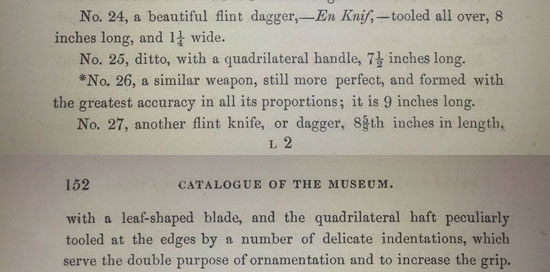Late Neolithic
Late Neolithic Flint Daggers from Denmark
What can one small object tell us about status and industry in prehistoric society?
By Rachel FlynnThe Copenhagen connection
“In the year 1816, and again in 1848, his Majesty the King of Denmark, at the instance of the Royal Society of Antiquaries of Copenhagen, presented to the Academy a collection of Scandinavian antiquities, principally composed of flint and stone weapons and tools, or models thereof”.
Among this group, described in this excerpt from William Wilde’s 1857 catalogue, was a set of flint daggers that display a style and skill unique to Scandinavia during the Late Neolithic period. They are a small representation of the substantial collection of Scandinavian artefacts and books that were gifted to the Royal Irish Academy throughout the 19th century.
This academic exchange was bolstered by the then recent discoveries of Viking sites at Kilmainham and Islandbridge, developing an archaeological understanding of the relationship between Ireland and Scandinavia. Similarly, a number of Irish artefacts were donated to the Royal Museum of Northern Antiquities, now the National Museum of Denmark, where they remain today.
A change in the fabric of society
The Late Neolithic was a time of important social change, defined by the introduction of metallurgy. The copper dagger was precursor to a brand new assemblage that would define the Bronze Age, including the sword, thought to be the first object designed for the sole purpose of killing other human beings.
This was the rise of individual power and status, indicated by the emergence of rich single burials that replaced more communal Neolithic traditions. In the south west of England, burials like that of the Amesbury archer, a migrant craftsman from the Alpine region who knew the secrets of metallurgy, show the importance of such magical knowledge. Since metal appeared to be held in such high regard at this time, it is easy to understand why flint daggers, such as those in our collection, were originally thought to be skeuomorphs, or imitations, of their copper counterparts.

Imitation, the sincerest form of flattery?
The similarity in form between the flint and copper daggers cannot be denied. Also, Scandinavia lacked a sustainable supply of copper ore to support a metallurgical industry so was thought to have lacked the ability, rather than the will, to produce copper daggers. However, there are some interesting pieces of evidence that cast significant doubt over the skeuomorphic theory. Firstly, there is the development of the flint dagger from the simpler, ovate Type I to the advanced Types III and IV, incorporating more complicated knapping techniques and displaying increasing skill levels.
Secondly, there is the suggestion that the delicate finishing on the later dagger forms could only have been completed with the aid of a metal-tipped tool. Not only were the daggers becoming more representative of advanced flint knapping, they continued to be favoured despite the apparent access to metal and metal tools.
More than the sum of its parts
So what does this tell us about the importance of the dagger in the Late Neolithic? More than a simple trinket of metalworking societies, perhaps these flint alternatives offer an insight into the purpose of dagger ownership. Microwear analysis on flint daggers reveals that they were unlikely to have been used for practical purposes. The wear was found to be consistent with frequent removal from a protective sheath. Much like a smartphone today, the dagger may have been a symbol of its owner’s patronage of new innovation and technology. It may have offered a means to show both friends and strangers what its owner could afford to be part of in a way that was easily translatable across Late Neolithic society.
The dagger also presents evidence of a new approach to craftsmanship. Just as metalworking skills required an investment of time and apprenticeship to acquire, so too did the knapping skills found on these daggers. Knapping specialist, Errett Callahan, asserts that it would have taken many years to reach the skill level required to make these daggers, requiring a specialised industry employing devoted craftspeople with considerable inherent talent.
Learn more
These flint daggers are in the Antiquities reserve collection. However, the earliest products of European metallurgy, including copper daggers, can be found in our Prehistoric Ireland exhibition. Ireland, unlike Scandinavia, had a plentiful supply of copper ore, you can also see the raw material and tools required to extract it.
References
- Frieman, C.J. (2012). Flint daggers, copper daggers, and technological innovation in late Neolithic Scandinavia. European Journal of Archaeology. 15(3), pp. 440-464
- Lomborg, E. (1973). Die Flintdolche Dänemarks: Studien über Chronologie und Kulturbeziehungen der südskandinavischen Spätneolithikums. København, Lynge
Location:
Late Neolithic Flint Daggers from Denmark is located at:
In Storage
Previous artefact:
Next artefact:
Late Roman Amphora Sherds from Co. Waterford
